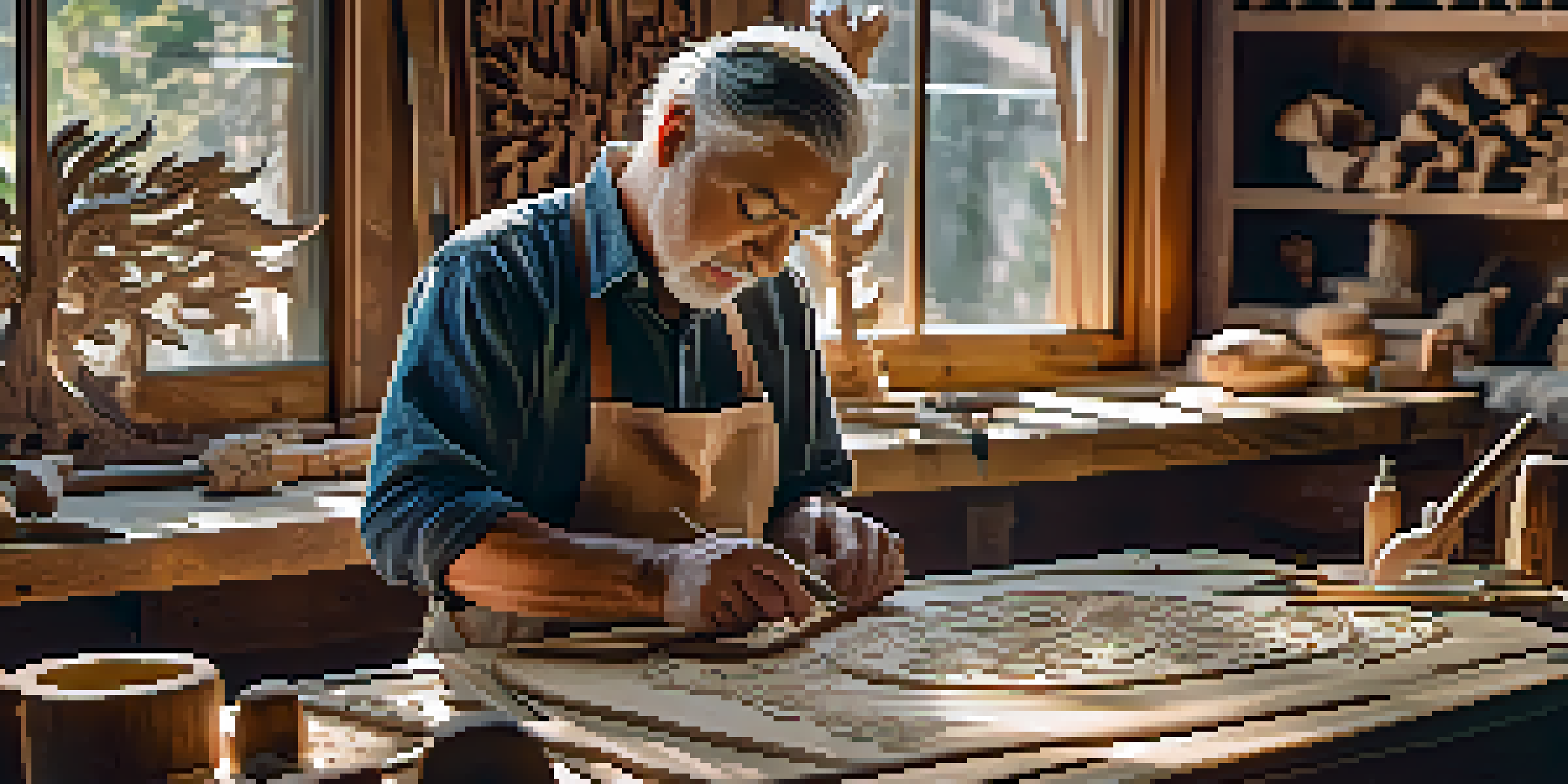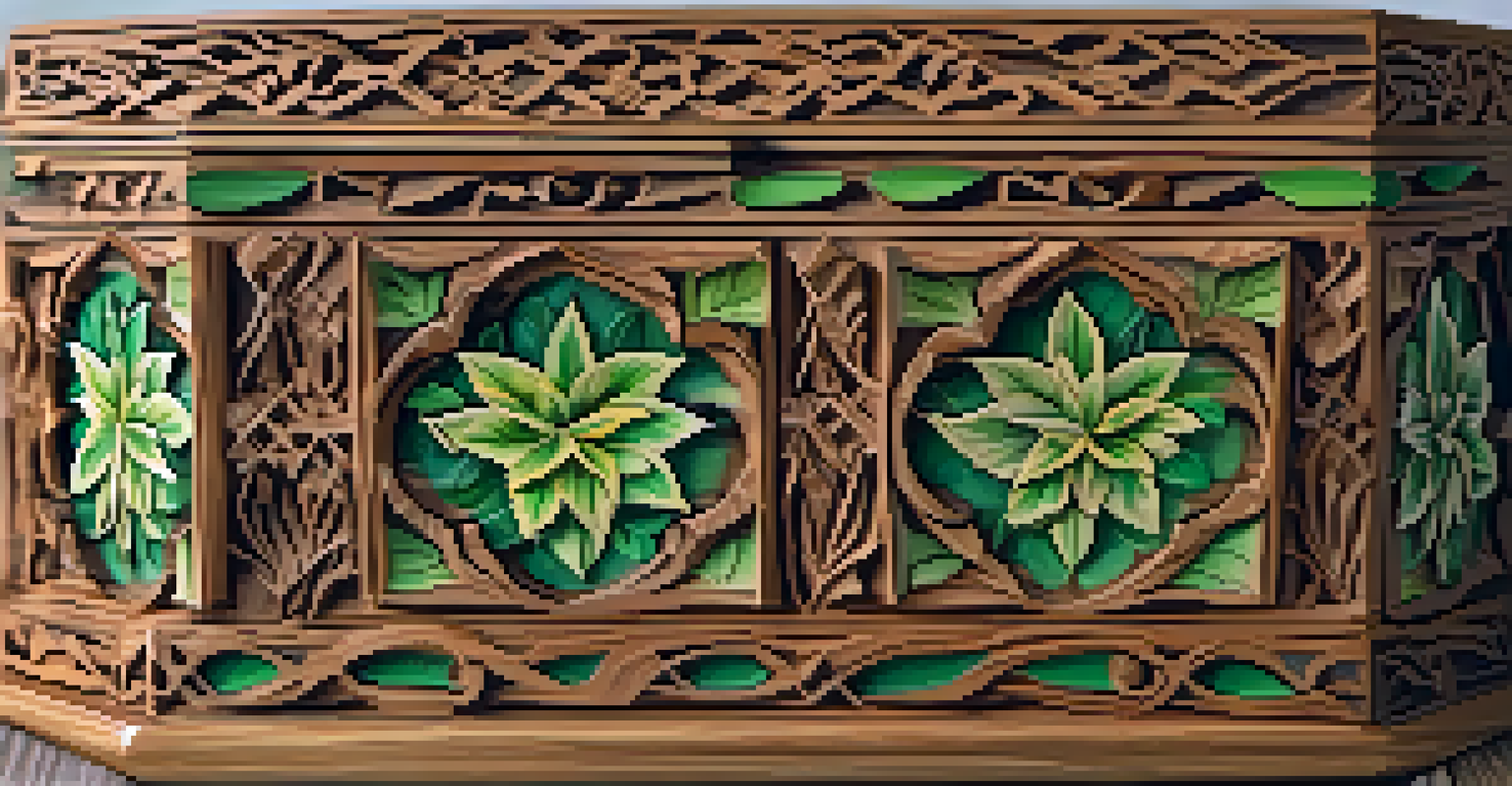Advanced Wood Carving Techniques YouTube Tutorials

Understanding Advanced Wood Carving Techniques
Advanced wood carving techniques build on the basics, allowing artisans to create intricate designs and textures. Techniques like relief carving, chip carving, and inlay work elevate the craft, giving depth and personality to wooden pieces. By mastering these skills, carvers can transform simple blocks of wood into stunning works of art.
Every artist was first an amateur.
Before diving into these advanced methods, it's crucial to have a solid grasp of fundamental skills such as proper tool handling and wood selection. This foundational knowledge not only enhances the quality of your work but also boosts your confidence as you take on more complex projects. Think of it as learning to walk before you can run.
As you explore advanced techniques, remember that practice is key. Each carving project offers a new opportunity to refine your skills and experiment with different styles. Embrace the learning process and don't shy away from making mistakes; they often lead to the most valuable lessons.
Finding the Right YouTube Tutorials
YouTube is a treasure trove of wood carving tutorials, but finding the right ones can be overwhelming. Look for channels that focus specifically on advanced techniques, as they often provide detailed step-by-step guidance. Popular channels like 'Woodworking for Mere Mortals' and 'The Wood Whisperer' offer a wealth of information suited for all skill levels.

When selecting tutorials, pay attention to the instructor's teaching style and clarity. A good tutorial should not only demonstrate techniques but also explain the reasoning behind each step. This approach helps you understand the craft more deeply, making it easier to apply what you've learned in your own projects.
Master Basic Skills First
A solid understanding of fundamental wood carving skills is essential before tackling advanced techniques.
Don't forget to engage with the community! Comment sections often contain valuable insights and tips from fellow woodworkers. By participating in discussions, you can enhance your learning experience and forge connections with like-minded enthusiasts.
Essential Tools for Advanced Wood Carving
Investing in the right tools is essential for mastering advanced wood carving techniques. High-quality chisels, gouges, and knives make a significant difference in your work's precision and finish. Brands like Flexcut and Pfeil are popular among woodworkers for their durability and sharpness.
Mistakes are the portals of discovery.
In addition to carving tools, consider acquiring a good set of safety equipment. Protective gloves, goggles, and a dust mask can help prevent injuries and keep you safe while you carve. Remember, a safe workspace allows you to focus on your creative process without unnecessary worries.
Lastly, don't overlook the importance of maintenance. Regularly sharpening your tools and keeping them in good condition will enhance their performance and longevity. Think of it like tuning a musical instrument; a well-maintained tool makes for a more harmonious carving experience.
Techniques to Enhance Your Carving Skills
To truly advance your wood carving skills, practice diverse techniques that challenge your comfort zone. Techniques such as undercutting and texturing can add depth and interest to your projects. By incorporating these methods, you can create visually stunning pieces that captivate viewers.
Consider setting up a dedicated practice schedule to focus on these new techniques. Just like athletes train regularly, consistent practice helps solidify your skills and speed up your learning process. Carving small, manageable projects can be an excellent way to experiment without feeling overwhelmed.
Engage with the Woodworking Community
Joining wood carving forums and participating in workshops can provide valuable insights and connections with other enthusiasts.
Don't hesitate to seek feedback on your work. Sharing your progress with fellow woodworkers, whether online or in person, can provide fresh perspectives and constructive criticism. Embrace the feedback as a chance to grow and refine your technique.
Project Ideas for Advanced Wood Carving
Once you've honed your advanced skills, it's time to tackle some exciting projects! Consider creating intricate decorative boxes, ornate picture frames, or detailed relief carvings that depict nature scenes. Each project can showcase your newfound techniques while allowing for creative exploration.
Another great idea is to collaborate with other artists. Combining different mediums, such as wood and metal or wood and fabric, can lead to unique, eye-catching pieces. This collaboration often sparks inspiration and pushes you to experiment with new styles and techniques.
Lastly, don't forget to document your projects! Taking photos of your work allows you to track your progress and share your achievements with the community. Plus, it can be incredibly motivating to look back at how far you've come in your carving journey.
Learning from Mistakes in Wood Carving
Mistakes are an inevitable part of the wood carving journey, and they can often lead to some of the most valuable lessons. Whether it's a chipped piece or an uneven cut, each error provides an opportunity to reflect and improve. Embracing these moments with a positive mindset can significantly enhance your learning experience.
Try to analyze what went wrong and think about how you could prevent similar issues in the future. This reflective practice not only helps you develop better techniques but also reinforces your problem-solving skills. Remember, even the most experienced woodworkers have their share of mishaps.
Embrace Mistakes for Growth
Learning from errors in wood carving not only improves your skills but also fosters a supportive learning environment.
Sharing your mistakes with the community can also foster a supportive environment. Many woodworkers are eager to help others learn from their experiences. By being open about your challenges, you contribute to a culture of growth and collaboration.
Building a Community Around Wood Carving
Joining a wood carving community can be immensely beneficial as you navigate advanced techniques. Online forums, social media groups, and local carving clubs offer a supportive space to share ideas, seek feedback, and learn from others. Engaging with fellow woodworkers can inspire you and provide valuable resources.
Consider participating in workshops or carving events to connect with other enthusiasts in person. These gatherings often feature demonstrations from skilled artisans and offer hands-on opportunities to practice new techniques. Building relationships in the carving community can lead to mentorship and collaboration opportunities.

Lastly, don't underestimate the power of sharing your journey online. Whether you post your projects on social media or start a dedicated YouTube channel, showcasing your work can inspire others and create a sense of accountability in your practice. Plus, you might just discover new friendships along the way.